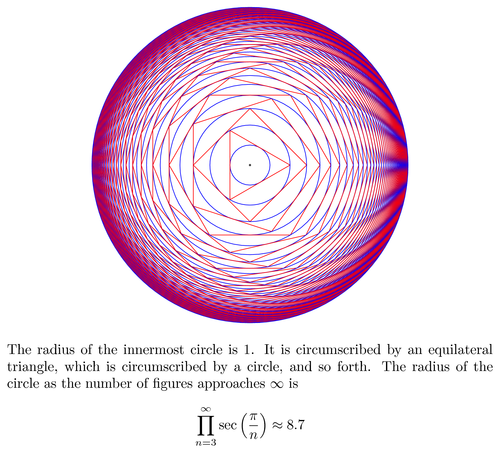The figure is a unit circle, circumscribed by an equilateral triangle, circumscribed by another circle, circumscribed by a square, circumscribed by a circle, etc. (Interestingly enough, the radius of the circle sequence converges, so it makes for a pretty picture.) A Matlab script computes the circle radii and the polygons' vertices and creates a set of TikZ lines in a separate file for the rendering of the image. Then a separate tex file is used to include the created TikZ file.
The Matlab script src.m used to generate the figure is:
% This Matlab script creates a set of LaTeX lines to generate a picture in
% TikZ. The picture is a unit circle, circumscribed by an equilateral
% triangle, circumscribed by a circle, circumscribed by a square,
% circumscribed by a circle, etc. Here Matlab is used to generate the
% sizes of the figures and the locations of the vertices of the polygons,
% while TikZ is used to render a beautiful image.
fo = fopen('yl.tikz','w');
% The initial circle's radius:
r1 = 1;
% These commands are used to render a plot in Matlab, just to check that
% things are working correctly. Uncomment if desired:
%
% t = linspace(0,2*pi,100);
% x1 = r1*cos(t); y1 = r1*sin(t);
% plot(x1,y1,'linewidth',1.5);
% hold on
% axis square; axis equal;
fprintf(fo,'\\begin{tikzpicture}[scale=0.5]\n');
fprintf(fo,'\\draw (0,0) circle (1pt);\n');
fprintf(fo,'\\draw[blue] (0,0) circle (1);\n');
for n = 3:50
% Radius of the next circle:
r2 = r1*sec(pi/n);
% Angle between successive vertices of the polygon:
dtheta1 = 2*pi/n;
% (x,y) coordinates of the vertices of the polygon:
px2 = r2*cos((0:n)*dtheta1);
py2 = r2*sin((0:n)*dtheta1);
% Issue the plotting commands in TikZ:
fprintf(fo,'\\draw[red] ');
for j = 1:n
fprintf(fo,'(%f,%f) -- ',px2(j),py2(j));
end
fprintf(fo,'cycle;\n');
% More Matlab plotting commands, if desired:
% x1 = r2*cos(t); y1 = r2*sin(t);
% plot(x1,y1,'linewidth',1.5);
% Draw the next circle, and then iterate to the next polygon:
fprintf(fo,'\\draw[blue] (0,0) circle (%f);\n',r2);
r1 = r2;
end
fprintf(fo,'\\end{tikzpicture}\n');
fclose(fo);
To compile the example you will need the files:

Edit and compile if you like:
\documentclass{article}
% Author: Brian S. Marks
% Title: scr.tex
% This latex file should be paired with the Matlab script scr.m, which
% creates the included yl.tex file. The Matlab script creates a set of
% TikZ lines that create the figure of a circle circumscribed by a
% regular triangle, circumscribed by a circle, circumscribed by a
% square, etc.
\usepackage{tikz}
\begin{document}
\begin{center}
\input{yl.tikz}
\end{center}
The radius of the innermost circle is 1. It is circumscribed by an
equilateral triangle, which is circumscribed by a circle, and so forth.
The radius of the circle as the number of figures approaches $\infty$ is
\[
\prod_{n=3}^\infty \sec\left(\frac{\pi}{n}\right) \approx 8.7
\]
\end{document}
Click to download: circumscribed-polygons-and-circles.tex • circumscribed-polygons-and-circles.pdf
Open in Overleaf: circumscribed-polygons-and-circles.tex